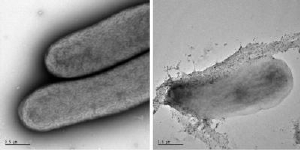Apr 23 2008
A newly created microbe produces cellulose that can be turned into ethanol and other biofuels, report scientists from The University of Texas at Austin who say the microbe could provide a significant portion of the nation's transportation fuel if production can be scaled up.
 Left: Two rod-shaped, wild type cyanobacteria. Note the conspicuous absence of any cellulose or sugars on the surface of these cells. Right: A genetically altered cyanobacterium that produced highly visible cellulose (marked by cellulase coupled with an electron dense gold marker). (Credit: Brown and Nobles, the University of Texas at Austin)
Left: Two rod-shaped, wild type cyanobacteria. Note the conspicuous absence of any cellulose or sugars on the surface of these cells. Right: A genetically altered cyanobacterium that produced highly visible cellulose (marked by cellulase coupled with an electron dense gold marker). (Credit: Brown and Nobles, the University of Texas at Austin)
Along with cellulose, the cyanobacteria developed by Professor R. Malcolm Brown Jr. and Dr. David Nobles Jr. secrete glucose and sucrose. These simple sugars are the major sources used to produce ethanol.
“The cyanobacterium is potentially a very inexpensive source for sugars to use for ethanol and designer fuels,” says Nobles, a research associate in the Section of Microbiology and Molecular Genetics.
Brown and Nobles say their cyanobacteria can be grown in production facilities on non-agricultural lands using salty water unsuitable for human consumption or crops.
Other key findings include:
- The new cyanobacteria use sunlight as an energy source to produce and excrete sugars and cellulose
- Glucose, cellulose and sucrose can be continually harvested without harming or destroying the cyanobacteria (harvesting cellulose and sugars from true algae or crops, like corn and sugarcane, requires killing the organisms and using enzymes and mechanical methods to extract the sugars)
- Cyanobacteria that can fix atmospheric nitrogen can be grown without petroleum-based fertilizer input
They recently published their research in the journal Cellulose.
Nobles made the new cyanobacteria (also known as blue-green algae) by giving them a set of cellulose-making genes from a non-photosynthetic “vinegar” bacterium, Acetobacter xylinum, well known as a prolific cellulose producer.
The new cyanobacteria produce a relatively pure, gel-like form of cellulose that can be broken down easily into glucose.
“The problem with cellulose harvested from plants is that it’s difficult to break down because it’s highly crystalline and mixed with lignins [for structure] and other compounds,” Nobles says.
He was surprised to discover that the cyanobacteria also secrete large amounts of glucose or sucrose, sugars that can be directly harvested from the organisms.
“The huge expense in making cellulosic ethanol and biofuels is in using enzymes and mechanical methods to break cellulose down,” says Nobles. “Using the cyanobacteria escapes these expensive processes.”
Sources being used or considered for ethanol production in the United States include switchgrass and wood (cellulose), corn (glucose) and sugarcane (sucrose). True algae are also being developed for biodiesel production.
Brown sees a major benefit in using cyanobacteria to produce ethanol is a reduction in the amount of arable land turned over to fuel production and decreased pressure on forests.
“The pressure is on all these corn farmers to produce corn for non-food sources,” says Brown, the Johnson & Johnson Centennial Chair in Plant Cell Biology. “That same demand, for sucrose, is now being put on Brazil to open up more of the Amazon rainforest to produce more sugarcane for our growing energy needs. We don’t want to do that. You’ll never get the forests back.”
Brown and Nobles calculate that the approximate area needed to produce ethanol with corn to fuel all U.S. transportation needs is around 820,000 square miles, an area almost the size of the entire Midwest.
They hypothesize they could produce an equal amount of ethanol using an area half that size with the cyanobacteria based on current levels of productivity in the lab, but they caution that there is a lot of work ahead before cyanobacteria can provide such fuel in the field. Work with laboratory scale photobioreactors has shown the potential for a 17-fold increase in productivity. If this can be achieved in the field and on a large scale, only 3.5 percent of the area growing corn could be used for cyanobacterial biofuels.
Cyanobacteria are just one of many potential solutions for renewable energy, says Brown.
“There will be many avenues to become completely energy independent, and we want to be part of the overall effort,” Brown says. “Petroleum is a precious commodity. We should be using it to make useful products, not just burning it and turning it into carbon dioxide.”